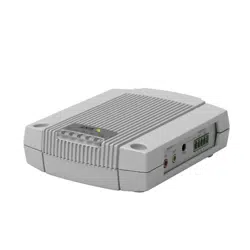Loading ...
Loading ...
Loading ...

10
AXIS P8221 - Audio Streams
Audio Streams
AXIS P8221 provides several audio stream formats. Your requirements and the properties of your network will determine the
type you use.
The Live View page provides access to audio streams. Other applications and clients can access audio streams directly, without
going via the Live View page.
AXIS Media Control (AMC)
AXIS Media Control (AMC) in Internet Explorer in Windows is the
recommended method of accessing audio from the product.
The AMC Control Panel can be used to configure various audio and
network settings. Please see the AXIS Media Control User’s Manual for
more information.
The AMC Control Panel is automatically installed on first use, after which
it can be configured. Open the AMC Control Panel from:
• Windows Control Panel (from the Start menu)
• Right-click above the AMC Toolbar on the Live View page and
select Settings
AXIS Media Control negotiates with the network product to determine
the transport protocol to use. Deciding which combination of protocols
and methods to use depends on your requirements, and on the properties
of your network. The order of priority, listed in the AMC Control Panel,
can be changed and the options disabled, to suit specific requirements.
Unicast RTP This unicast method (RTP over UDP) is used
for live unicast audio, especially when it is
important to always have an up-to-date
stream, even if some audio data is lost.
Unicasting is used for audio-on-demand transmission,
so that there is no traffic on the network until a client
connects and requests the stream.
Note that there are a maximum of 20 simultaneous
unicast connections.
RTP over RTSP This unicast method (RTP tunneled over
RTSP) is useful as it is relatively simple to
configure firewalls to allow RTSP traffic.
RTP over RTSP over
HTTP
This unicast method can be used to traverse
firewalls. Firewalls are commonly configured
to allow the HTTP protocol, thus allowing
RTP to be tunneled.
Multicast RTP This method (RTP over UDP) should be used for live multicast audio. The stream is always
up-to-date, even if some audio data is lost.
Multicasting provides the most efficient usage of bandwidth when there are large numbers of cli-
ents accessing audio simultaneously. A multicast cannot however, pass a network router unless
the router is configured to allow this. It is not possible to multicast over the Internet, for example.
Note also that all multicast clients count as one unicast client in the maximum total of 20 simul-
taneous connections.
Loading ...
Loading ...
Loading ...
